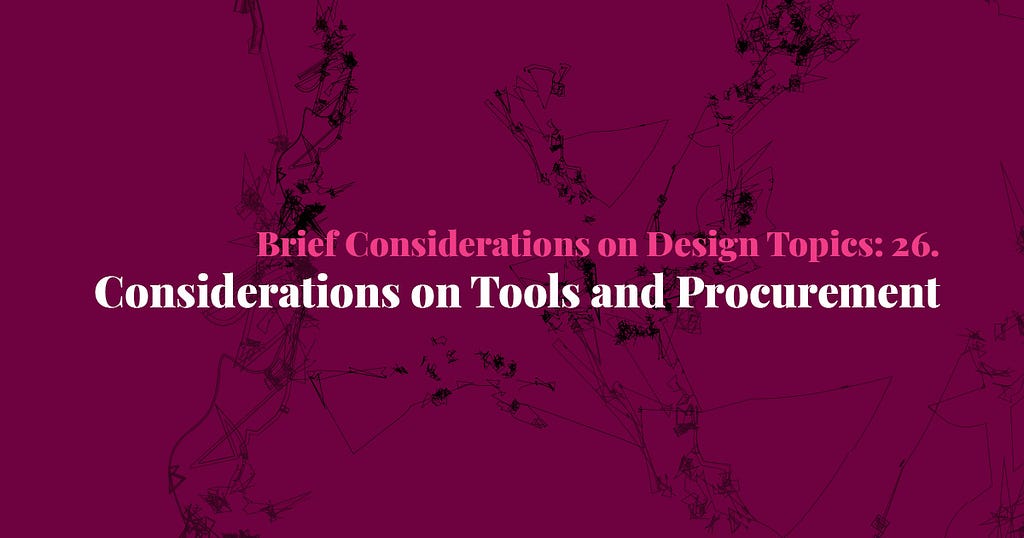
One of the organizations I worked for in the past has (or had) a rather comprehensive and dare I say it, inefficient and exhausting procurement process for new tools. That process has stayed with me for quite some time since I was the main instigator for the procurement of tools, and invariably found myself going through that entire process on my own. It has sparked this reflection on the importance of tools and the timeliness of their procurement.
- Tools are fundamental for efficiency of Design Teams. I’ve never been a part of a Design Group or Discipline where Design Tools were not aimed at improving how Designers work. The point to tools is always to improve productivity and output for Designers. Failing the capitalize on emerging or ever evolving tools portfolio denies teams the ability to bring further value and ultimately business to the organization (solid tools >>> less time working through the process = less costs through a process of crafting a solid solution).
- Tools walk hand in hand with timeliness. Case in point, everyone is surrounded by AI all the time. Even those who don’t exactly know how to use it for their work, find ways to incorporate it either leveraging its research/canvasing abilities, or writing emails, or summarizing meetings (to name but a few capabilities). It’s important that Designers have access to tools of the moment, that impact their workflow, allowing them to be more pertinent, relevant, and insightful as they go through a Design process. Timeliness is also tied with the ability to move faster, courtesy of tools that disrupt the status quo and enable Designers to push how they produce their output (for those who have worked in Print Design, one only has to remember when Quark Xpress or Adobe InDesign came along and changed pagination layouts forever).
- Tools enable professionals to stay relevant in the job market. Product Design lives from the fact that the world is constantly shifting, users’ needs are continuously evolving, and new solutions are needed all the time. This means Designers need to be of the moment or stay well versed on what is happening in the market. Adopting new tools isn’t an exercise in futility or being seduced by the shiny new solution. It means being able to understand how product solutions are evolving, how they’re addressing pertinent needs (even if it is their own). This eventually also means Designers who are working on relevant and pertinent tools are that much qualified to transfer between jobs and opportunities than those who work in legacy applications. I’m not intending to demonize legacy or older Tools, but those who fail to evolve with time end up being sequestered into scenarios of utilization that are more and more fringe (dated scenarios of utilization). It’s important for Designers to have the latitude to move towards whatever opportunity they want, and having the ability to work with modern and pertinent tools increases their skill set.
- Tools are costly and shouldn’t bet be the sole focus of a solid Design professional. Fair points one may retort. Tools are indeed costly and are a considerable investment from and for the Organization. That’s why it’s important to get the right tools, and to make sure the costs of subscribing or getting them are offset by the value the tools generate. And while tools should not be the sole focus of a Designer, they should be part of it. Understanding how tools work, allows for a thoughtful and strategic Designer to think how the process can move more efficiently, how it can bring more insights, value, collaboration, clarity, not only to themselves but also to all the collaborators who are part of the Design process. Having the right tools isn’t beneficial solely for Designers, but is in fact incrementally valuable for everyone who is a part of the Design process.
- Procurement should be rigorous, but operate with timeliness, not against the teams it serves. All tools should be evaluated for security, data confidentiality, reliability, stability, customer support, and the list goes on. However, it should also be efficient in order to prevent those who procure them from spending timeless hours on something that should be a succinct and substantial endeavor (meaning it should take a fair amount of weeks, not months nor years).
I’ve written various articles on tools before (you can read them here, here, and here), but at a time where a resource such as AI dominates all the airwaves, wherever you go, it’s important to think about why and how we should move forward, and not just blindly stay either in the back, or simply adopt something without thinking why it matters towards what we do and what we should be doing.
Carl Jung wrote:
“I am not what happened to me, I am what I choose to become.”
Brief Considerations on Design Topics: 26. Considerations on Tools and Procurement was originally published in UX Planet on Medium, where people are continuing the conversation by highlighting and responding to this story.